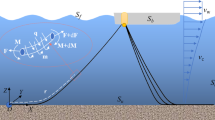Abstract
This paper describes the model test and the virtual simulation respectively for the VLCC class FPSO hookup, as well as addresses their different applications to the mating operation between the FPSO and the soft yoke mooring system (SYMS) in extremely shallow water. The scope of the model test and the virtual simulation covers various installation stages including a series of positioning trials, positioning keeping and temporary mooring to the pre-installed SYMS mooring tower, pendulum mating, and yoke ballasting to storm-safe. The model test is to accurately verify bollard pull capacity to keep the FPSO in position and assess motion responses and mooring loads for the FPSO and installation vessels during various installation stages. The virtual simulation is to provide a virtual-reality environment, thus realistically replicating the hookup operation at the Simulation Test Center (STC) facility and identifying any deficiencies in key installation personnel, execution plan, or operation procedures. The methodologies of the model test and the virtual simulation addressed here can be easily extended to the deepwater applications such as positioning and installation operations of various floating systems.
摘 要
阐述了 VLCC 级 FPSO 海上连接的模型试验和虚拟模拟, 以及其研究结果如何应用于指导FPSO 与 SYMS 在极浅水中的连接作业。 模型试验和虚拟模拟研究范围覆盖了各安装阶段, 包括海上就位试验、 就位及连接临时交叉缆、 系泊腿连接、 压载灌浆直至达到风暴安全状态。 模型试验不仅可以核实 FPSO 就位拖拉力要求, 而且可以确定 FPSO 和安装驳船的运动幅值和系泊力大小。 而虚拟模拟则可以虚拟模拟环境, 通过虚拟模拟确认关键作业人员、 作业执行方案和作业程序中潜在的问题。 该文介绍的模型试验和虚拟模拟方法可以进一步推广到各种浮式平台的深水应用中。
Similar content being viewed by others
References
XIAO L F, YANG J M, HU Z Q. Low frequency and wave forces and wave induced motions of a FPSO in shallow water[C]// Proceedings of 26th OMAE. San Diego, 2007: OMAE2007-29047.
WANG K, WANG X. Study of wave drift forces affecting FPSO systems[J]. Journal of Harbin Engineering University, 2008, 29(12): 1261–1265(in Chinese).
MA Y D, WANG Y Y. Comparative analysis for designing and manufacturing of FPSO and conventional tankers[J]. Journal of Harbin Engineering University, 2008, 29(10):1030–1035(in Chinese).
LI H, REN H L, LIU R M, et al. 3-D hydroelastic method for analysis of motion and wave loads of an FPSO ship[J]. Journal of Harbin Engineering University, 2008, 29(8):789–793(in Chinese).
STC B V. SAAR∖STC0559 FPSO positioning in the Bohai Bay, simulator based testing and training[S]. Rotterdam, 2008.
Author information
Authors and Affiliations
Corresponding author
Additional information
Foundation item: Supported by the Fund from COPC PL19-3 FPSO Project.
HAO Jun was born in 1971. He is a Deputy Manager at COOEC Installation Division. He had worked as a technical supervisor and installation manager in many offshore projects. He has particular experience in offshore installation and project management. He earned his B.S. degree in naval architecture from Harbin Engineering University. His current research interests include development of innovative offshore installation methodology.
SUN Yu-zhu was born in 1979. He is an Installation Manager for various offshore projects. He had worked as a field engineer, installation engineer, and installation manager in many offshore projects. He has particular experience in offshore installation and project management. He earned his B.S. degree in marine engineering from Wuhan University of Technology. His current research interests include development of innovative offshore installation methodology and equipment.
WU Zi-Quan was born in 1950. He is a senior engineer and Deputy Director at the Technology Center, COOEC Installation Division. He had ever worked as a field engineer, installation engineer and manager in various offshore projects. He has particular experience in offshore installation and project management. He earned his B.S. degree in ocean engineering from Tianjin University. His current research interests include development of innovative offshore installation methodology and equipment.
WANG, Alan Minglun was born in 1963. He is a senior advisor at COOEC Installation Division. He had worked as a naval architect and installation engineer for KBR, Noble Denton, & ABS with over 14 years’ experience in design and installation of offshore platforms and marine vessels. He earned his B.S. in naval architecture from Jiangsu University of Science & Technology, and his is a M.S. in ocean engineering at the University of Hawaii at Manoa, a PhD in naval architecture & marine engineering at the University of Michigan plus a MSE in mechanical engineering as well. His current research interests include development of innovative installation technology and methodology.
Rights and permissions
About this article
Cite this article
Hao, J., Sun, Yz., Wu, Zq. et al. Model test vs virtual simulation of a VLCC FPSO hookup. J. Marine. Sci. Appl. 8, 137–143 (2009). https://doi.org/10.1007/s11804-009-8106-0
Received:
Published:
Issue Date:
DOI: https://doi.org/10.1007/s11804-009-8106-0




